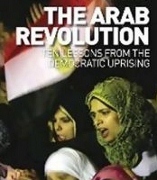The Ten Lessons in 10 chapters begin with, “During the past decades, Arabs have been singled out in international debate for being unique. This special treatment was certainly no badge of honour. Something was wrong, twisted, wasted from the Atlantic Ocean to the Persian Gulf, where the Arab people were supposed to form a community (ummah).” Filiu traces Arab history from 1916, when the Arabs revolted against the Ottoman Empire, with support from France and the UK.
In Lesson One, he outlines the failed attempts by various Arab leaders at unification. The creation of Israel further disrupted unification. Now, the Arabs are back in the world headlines due to the popular uprisings.
In Lesson Two, Filiu points out the differences in the uprisings of Tunisia, Egypt, Libya, Syria, Jordan…and the people’s widespread abuse by corrupt rulers.
In Lesson Three, Filiu gives statistics of the Arab youth, “60% of the Arab population is under 25 years old, which is twice the world average — the underemployment is hitting hard!” Furthermore, the education diplomas provided, do not match the technical and mechanical skills required in international markets. The internet is widely accessed; nearly everyone has mobile phones. Moreover, several satellite channels have surfaced. The youth therefore has greater expectations than their parents, being exposed to the globalised world. The predatory tendencies of the close-knit ruling cliques, which control the national resources are related to job allocations. The youths augur that the power in their rage could be the energy of the future.
Lesson Four comments on the power of technology, as Filiu details the profusion of cyber cafes and satellite channels, Facebook, Twitter and blogs, via which the youth popularises their freedom slogans. Massive online communities have been created via virtual protestors online, which were hugely successful in Egypt. The Libyan exiled opposition’s on line manifesto for ‘The Day of Rage’ on February 17, 2011, was led by an aggressive military build-up.
Lesson Five comments on the ‘leaderless movements’ but fails to comment on the status of post-overthrow of the old regimes. These revolutions just want to break the shackles, without considering the post-overthrow chaos. The Day of Rage in Egypt was the culmination of three weeks of planning and symbolic sites were taken over by protestors.
Filiu’s critical and clinical analysis continues in five more chapters. If this book review were to go through all ten chapters, why would anyone want to purchase this book?
About the author
Jean Pierre Filiu is Professor of Middle East Studies at Sciences Po in Paris and has held visiting professorships at Columbia University and Georgetown University. His books and articles on the Arab World have been printed in a dozen languages.
His latest book, The Arab Revolution: Ten Lessons from the Democratic Uprising is published by C. Hurst & Co. Ltd., 41 Great Russell Street, London DC1B 3PLwww.hurstpub.co.uk




